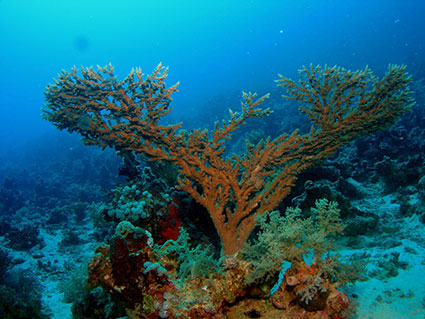Thursday, April 17, 2008
Bikini corals recover from atomic blast
 Half a century after the last earth-shattering atomic blast shook the Pacific atoll of Bikini, the corals are flourishing again. Some coral species, however, appear to be locally extinct.
Half a century after the last earth-shattering atomic blast shook the Pacific atoll of Bikini, the corals are flourishing again. Some coral species, however, appear to be locally extinct.These are the findings of a remarkable investigation by an international team of scientists from Australia, Germany, Italy, Hawaii and the Marshall Islands. The expedition examined the diversity and abundance of marine life in the atoll.
One of the most interesting aspects is that the team dived into the vast Bravo Crater left in 1954 by the most powerful American atom bomb ever exploded (15 megatonnes - a thousand times more powerful than the Hiroshima bomb). The Bravo bomb vapourised three islands, raised water temperatures to 55,000 degrees, shook islands 200 kilometers away and left a crater 2km wide and 73m deep.
After diving into the crater, Zoe Richards of the ARC Centre of Excellence for Coral Reef Studies and James Cook University says, “I didn’t know what to expect – some kind of moonscape perhaps. But it was incredible, huge matrices of branching Porites coral (up to 8 meters high) had established, creating thriving coral reef habitat. Throughout other parts of the lagoon it was awesome to see coral cover as high as 80 per cent and large tree-like branching coral formations with trunks 30cm thick. It was fascinating – I’ve never seen corals growing like trees outside of the Marshall Islands.
“The healthy condition of the coral at Bikini atoll today is proof of their resilience and ability to bounce back from massive disturbances, that is, if the reef is left undisturbed and there are healthy nearby reefs to source the recovery.”
However the research has also revealed a disturbingly high level of loss of coral species from the atoll. Compared with a famous study made before the atomic tests were carried out, the team established that 42 species were missing compared to the early 1950s. At least 28 of these species losses appear to be genuine local extinctions probably due to the 23 bombs that were exploded there from 1946-58, or the resulting radioactivity, increased nutrient levels and smothering from fine sediments.
“The missing corals are fragile lagoonal specialists – slender branching or leafy forms that you only find in the sheltered waters of a lagoon,” Zoe explains. While corals in general have shown resilience, Zoe adds that the coral biodiversity at Bikini Atoll has proven only partially resilient to the disturbances that have occurred there.
Extensive decontamination works have been carried out at Bikini atoll making it safe to visit, however local produce is unsafe to eat, and it is unlikely the Bikinian people will return to live on Bikini Atoll in the near future.
For comparison the team also dived on neighbouring Rongelap Atoll, where no atomic tests were carried out directly although the atoll was contaminated by radioactive ash from the Bravo Bomb and local inhabitants were also evacuated and for the most part, have not returned. The marine environment at this Atoll was found to be in a pristine condition.
The team thinks that Rongelap Atoll is potentially seeding Bikini’s recovery, because it is the second largest atoll in the world with a huge amount of coral reef diversity and biomass and lies upstream from Bikini.
Because of its incredible history and current undisturbed character Bikini Atoll is now part of a larger project to have northern Marshall Island Atolls World Heritage listed. The expedition served to illustrate the tragic history of the Bikinian people is not entirely reflected below the surface because the reefs of Bikini are recovering to present themselves as havens of abundance to the marine life of the Northern Pacific Ocean.
Journal Reference: Elsevier’s Marine Pollution Bulletin No. 56, March 2008 page 5-3-1-515.
Further Reading: ARC Centre of Excellence for Coral Reef Studies
What do you think of this news item? Start a discussion.
Bookmark with: del.icio.us | Digg | Newsvine | NowPublic | Reddit
|
--
Subscribe to SCUBA News (ISSN 1476-8011) for more free news, articles, diving reports and marine life descriptions - http://www.scubatravel.co.uk/news.html

Labels: coral, research, sealife